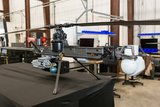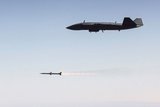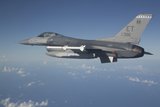Anduril UK and GKN Aerospace collaborate on British Army ACP bid
The pair will submit their demonstrator concept for Project Nyx, a development project for the British Army’s Land Autonomous Collaborative Platform.
Northrop Grumman's DSaT is installed on a CRJ-700. (Photo: Northrop Grumman)
The company said in a statement that during a simulated, real-world tactical scenario earlier this year, the system successfully gathered and fused multi-domain data for rapid dissemination to the Tactical Operations Center, collected and analysed data from commercial satellites using systems on board the aircraft and met all of the criteria for the experimentation.
DSaT is a multi-domain deep-sensing architecture integrated into a civilian aircraft, in this case a CRJ-700, providing intelligence collection that reaches beyond the visual LoS of local sensors.
While leveraging elements of the Tactical Intelligence Targeting Access Node pre-prototype system, its capability fills a gap in data collection by combining space-based geospatial intelligence (GEOINT) imagery with aerial and terrestrial intelligence from commercial and military space systems.
Phase 1 successfully demonstrated the GEOINT capabilities with future phases planned incorporating multiple intelligence platforms.
EDGE 23 was designed to test and evaluate new technologies and more than 80 were considered at this year’s event.
As part of the event UVision USA demonstrated the successful launch of its Hero 120 loitering munition from an airborne helicopter. The trial established the system's ability to complete a sensor-to-shooter cycle by launching the Hero 120 from a Bell 412EP helicopter and strike a ground target.
The event also saw Logos Technologies, a subsidiary of Elbit Systems of America, fly its BlackKite IR wide-area motion imagery pod on a US Army UAS for the first time.

The pair will submit their demonstrator concept for Project Nyx, a development project for the British Army’s Land Autonomous Collaborative Platform.

The Picatinny Common Lethality Integration Kit is designed to overcome the issue of unique integration methods between lethal payloads and drones as well as avoiding problematic acquisition conditions created by vendor lock.

The investment includes new contracts for six MQ-28A Ghost Bat aircraft, as well as provisional funds to invest in the development of a Block 3 prototype.

Italy could field the JASSM-ER for its combat aircraft including the F-35, while Denmark has been approved for AMRAAM and an Integrated Battle Command system procurement.

The newly unveiled collaborative combat aircraft looks to strike a balance between capability and cost-effectiveness, according to the company.

Following the completion of successful ground tests, one more exercise remains before flight testing can begin.